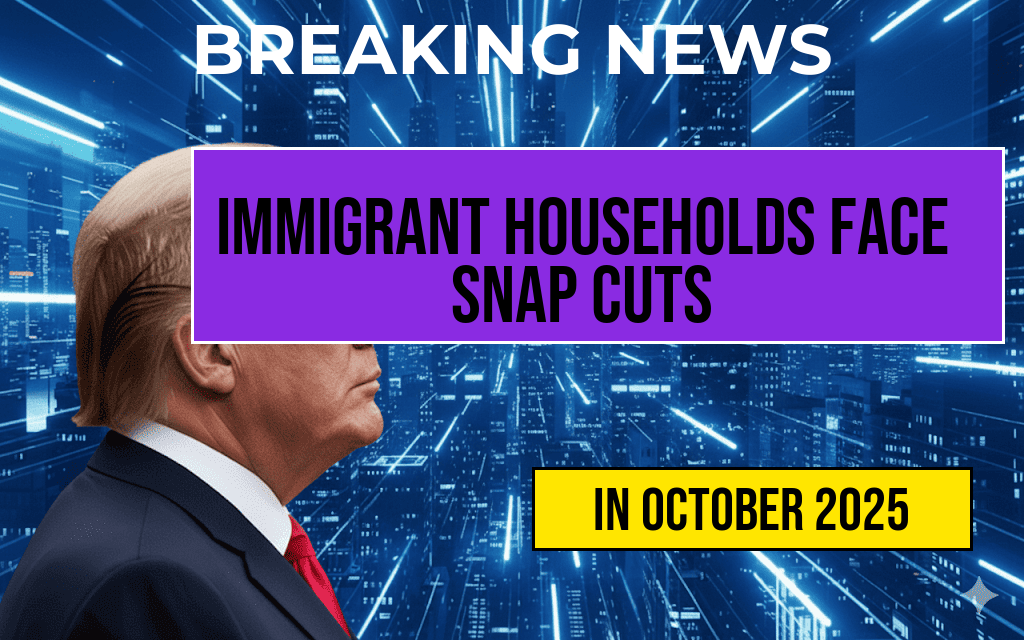Immigrant households across the United States are facing significant reductions in their Supplemental Nutrition Assistance Program (SNAP) benefits, with some losing up to $4,000 annually. This shift stems from recent policy changes that tighten eligibility criteria, particularly targeting immigrant populations who have historically relied on federal assistance to meet basic needs. These cuts come amid ongoing debates over immigration policy and social safety nets, raising concerns about food security among vulnerable communities. Families affected by these reductions often include working-class immigrants, many of whom are U.S. citizens or legal residents, but who face new restrictions based on their immigration status. As the landscape of federal aid becomes more restrictive, advocates warn that these changes could have ripple effects on public health, economic stability, and community well-being.
Policy Changes and Eligibility Restrictions
Background on SNAP Eligibility
The SNAP program, administered by the U.S. Department of Agriculture (USDA), is designed to provide nutritional assistance to low-income individuals and families. Traditionally, eligibility hinges on income levels, household size, and citizenship or lawful immigrant status. However, recent federal updates have altered the criteria, especially for immigrant households, making it more challenging for certain populations to qualify or retain benefits.
Recent Federal Initiatives
In 2023, the Biden administration implemented new rules aimed at reducing fraud and ensuring benefits are directed to U.S. citizens and lawful residents. These policies include:
- Implementing stricter verification processes for immigrant status.
- Reducing the income thresholds for eligibility.
- Limiting benefits for non-citizen households with certain immigration statuses.
According to official statements, these measures are intended to safeguard program integrity. However, critics argue they disproportionately impact immigrant families, many of whom have contributed significantly to local economies and communities.
Impact on Immigrant Households
Financial Losses and Food Security Concerns
Families affected by these policy changes face substantial financial hardships. Estimates suggest that some immigrant households could see their annual SNAP benefits cut by as much as $4,000. For families already struggling to make ends meet, these reductions threaten to worsen food insecurity, forcing difficult choices between paying rent, utilities, or purchasing nutritious food.
Particular Vulnerabilities
Immigrant households with mixed-status families—where some members are citizens and others are non-citizens—are especially vulnerable. Many of these families depend on the safety net provided by SNAP and other assistance programs. The new restrictions often exclude or diminish benefits for non-citizen members, even if they are children or legal residents.
Community and Economic Effects
Beyond individual households, these cuts could have broader implications. Reduced food assistance may lead to increased reliance on emergency services and local food banks. Economically, diminished purchasing power among immigrant communities can impact local businesses and overall neighborhood stability. Community organizations report heightened concern over the long-term effects on public health and social cohesion.
Responses from Advocacy Groups and Policymakers
Community and Advocacy Perspectives
Organizations advocating for immigrant rights and food security have condemned the recent policy shifts. They emphasize that access to nutrition is a fundamental human right and warn that further reductions could exacerbate health disparities. Groups such as the USDA and civil rights organizations are urging policymakers to reconsider eligibility restrictions.
Policy Responses and Legal Challenges
Some states are exploring ways to mitigate the impact, including expanding state-funded assistance programs. Meanwhile, legal challenges are underway questioning the legality of certain restrictions, with plaintiffs arguing that they violate federal statutes and constitutional protections against discrimination. Courts are expected to weigh in on whether these policy changes can withstand legal scrutiny.
Looking Ahead: Potential Solutions and Support Measures
Community-Based Initiatives
Local organizations are stepping up to fill the gaps left by federal reductions. Food pantries, religious groups, and non-profits are increasing outreach efforts to connect immigrant families with resources and emergency assistance. Some initiatives focus on multilingual outreach to ensure families understand their rights and available aid options.
Policy Recommendations
| Strategy | Description | Potential Impact |
|---|---|---|
| State-Level Assistance Programs | Funding or expanding state-funded nutrition programs to cover gaps | Provides immediate relief to affected families |
| Legal Challenges | Litigation to contest restrictive policies | May delay or reverse harmful policy changes |
| Community Outreach and Education | Enhancing awareness of rights and available resources | Empowers families to access aid and navigate eligibility |
As debates over immigration and social safety nets continue, the focus remains on balancing program integrity with the needs of vulnerable populations. The coming months will likely see increased advocacy, legal action, and policy adjustments aimed at addressing these emerging challenges.
Frequently Asked Questions
What are the recent changes to SNAP eligibility for immigrant households?
The recent policy updates have resulted in immigrant households facing cuts in SNAP benefits, with some losing up to $4,000 annually. These changes restrict access to benefits for many immigrant families.
Which immigrant groups are most affected by the SNAP benefit cuts?
Non-cit immigrant households, particularly those without lawful permanent resident status or limited work history, are most impacted by the reduction in SNAP eligibility.
How might these benefit cuts impact immigrant households financially?
With reductions of up to $4,000 in annual benefits, immigrant families may face increased food insecurity and financial hardship, affecting their ability to meet basic needs.
Are there any exceptions or programs that still support immigrant households with food assistance?
Some public assistance programs may still provide support to certain immigrant households, but overall, SNAP benefits are becoming less accessible due to new eligibility restrictions.
What can immigrant households do to prepare or respond to these SNAP changes?
Immigrant families should consult with local social services or legal advisors to understand their rights and explore alternative resources for food assistance and support during this transition.





